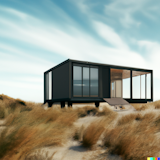Revolutionizing Prefab Housing: Treating the Floor as a Computer Circuit Board
Credits
From David Elze
The prefab housing industry is on the brink of a significant transformation, driven by the integration of artificial intelligence (AI) and advanced robotics. Frame&InFill, a leading prefab housing company, is pioneering this change by treating the floor of a house like a computer circuit board. This innovative approach allows for the optimization of mechanical systems, electrical wiring, and plumbing layouts, akin to optimizing circuits on a motherboard. This paper explores this groundbreaking concept and its potential to revolutionize the prefab housing industry.
The concept of treating the floor of a house like a computer circuit board is a novel approach that resonates with tech investors and engineers. Just as a circuit board is meticulously designed to optimize the placement of components and the routing of electrical connections, a house can be designed in the same way. The floor plan becomes the 'circuit board', and the rooms, mechanical systems, electrical wiring, and plumbing become the 'components'.
AI-Powered Floor Planning:
In this context, AI-powered floor planning becomes a tool for 'circuit optimization'. The AI algorithms analyze customer preferences, lifestyle, and requirements to propose personalized floor plans. These floor plans are optimized for efficient use of space, just as circuits are optimized for efficient use of power and processing resources.
Simultaneous Systems Optimization:
Simultaneously, the AI system optimizes the 'components' - the mechanical systems, electrical wiring, and plumbing layout. The AI system suggests the most efficient and resource-friendly arrangement of these systems, akin to a circuit designer placing and routing components on a circuit board to minimize power consumption and maximize performance.
Minimizing Waste:
Just as circuit designers strive to minimize waste in terms of power and processing resources, Frame&InFill's AI-driven approach minimizes material waste. By optimizing the layout of mechanical systems and utilities alongside floor planning, material usage is optimized, significantly reducing waste during the construction process.
Enhanced Energy Efficiency:
The concept extends to enhancing energy efficiency. By aligning mechanical systems and utilities with the floor plan, energy consumption is optimized, resulting in reduced carbon footprints and lower utility bills for homeowners. This is analogous to power optimization in circuit design, where components and connections are arranged to minimize power consumption.
AI-Enabled Personalization:
The integration of AI allows Frame&InFill to offer a highly personalized and interactive experience to customers. The platform learns from customer preferences and feedback, continually improving and refining suggestions. This level of customization empowers homeowners to co-create their dream living spaces with utmost efficiency and sustainability, much like a circuit designer would customize a circuit board to meet specific performance requirements.
Conclusion:
Frame&InFill's pioneering approach to integrating artificial intelligence into the design and systems optimization process signifies a transformative step forward in the prefab housing industry. By treating the floor of a house like a computer circuit board, the company is setting a new standard for sustainable, personalized, and efficient living. This innovative approach not only benefits homeowners with optimized living spaces but also resonates with tech investors and Silicon Valley engineers, who are familiar with the concept of circuit optimization. As Frame&InFill continues to leverage cutting-edge technologies, it solidifies its position as a trailblazer in the prefab housing sector, setting a new standard for sustainable, personalized, and efficient living.














